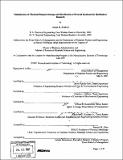Optimization of chemical reagent storage and distribution at Novartis Institutes for BioMedical Research
Author(s)
Bedford, Jordan M. (Jordan Mark)
DownloadFull printable version (5.167Mb)
Other Contributors
Leaders for Manufacturing Program.
Advisor
David Simchi-Levi and Charles L. Cooney.
Terms of use
Metadata
Show full item recordAbstract
The Novartis Institutes for BioMedical Research is the drug discovery arm of Novartis Pharmaceuticals. Drug discovery is generally considered to be the primary driver for success in the pharmaceutical industry. Success in the early stages of drug discovery relies on dependable, innovative, disease related high-throughput screening of biological compounds and the creation of a screening deck of highly diverse, proprietary chemical compounds. In contrast with many of its peers, Novartis relies strongly on combinatorial chemistry to populate its screening deck. The Chemical Libraries (CLI) group is responsible for this approach at Novartis and delivers more than 100,000 compounds per year to the Novartis Compound Archive. Since the introduction of high-throughput screening and combinatorial chemistry techniques, the bottleneck in many drug discovery processes has shifted to the roles that support these high-volume techniques. The aim of this thesis is to provide a general collection of short and long-term suggestions for process improvement in the chemical supply process. This process includes compound search and ordering, order fulfillment, and compound delivery, was investigated. (cont.) The chemical supply process is responsible for delivering compounds to chemists that would otherwise cost hundreds of dollars per compound with a delay of between one and four weeks, or would require a multiple day synthesis procedure. Stockroom automation, content and process scope, and physical layout were all evaluated. The following major conclusions were developed as a result of the research. First, the procedures for using the compound archives and libraries must be clearly presented to the end user so that s/he is fully able to utilize and contribute to the libraries. Second, compound libraries should be conglomerated into one large library that is also responsible for compound acquisition. Third, compound metering for intermediates does not appear to be an effective use of resources and should be severely restricted following the successful implementation of the SciQuest compound management system. Finally, compound libraries should use automated pick and place systems but metering and dispensing systems should remain manual.
Description
Thesis (S.M.)--Massachusetts Institute of Technology, Dept. of Materials Science and Engineering; and, (M.B.A.)--Massachusetts Institute of Technology, Sloan School of Management; in conjunction with the Leaders for Manufacturing Program at MIT, 2007. Includes bibliographical references (p. 81-82).
Date issued
2007Department
Leaders for Manufacturing Program at MIT; Massachusetts Institute of Technology. Department of Materials Science and Engineering; Sloan School of ManagementPublisher
Massachusetts Institute of Technology
Keywords
Materials Science and Engineering., Sloan School of Management., Leaders for Manufacturing Program.